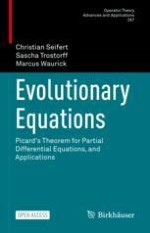This open access book provides a solution theory for time-dependent partial differential equations, which classically have not been accessible by a unified method. Instead of using sophisticated techniques and methods, the approach is elementary in the sense that only Hilbert space methods and some basic theory of complex analysis are required. Nevertheless, key properties of solutions can be recovered in an elegant manner. Moreover, the strength of this method is demonstrated by a large variety of examples, showing the applicability of the approach of evolutionary equations in various fields. Additionally, a quantitative theory for evolutionary equations is developed.
The text is self-contained, providing an excellent source for a first study on evolutionary equations and a decent guide to the available literature on this subject, thus bridging the gap to state-of-the-art mathematical research.

